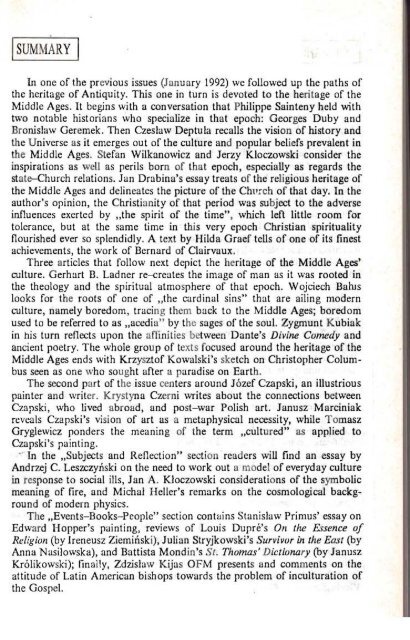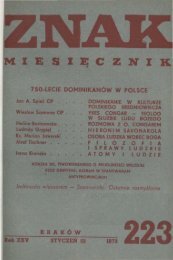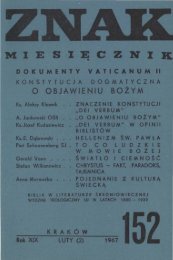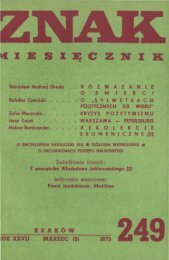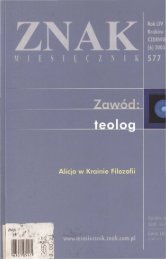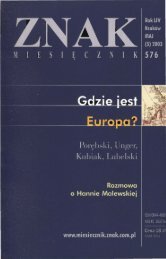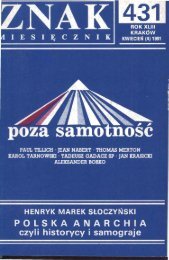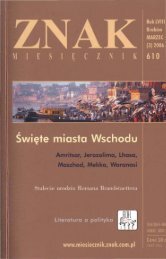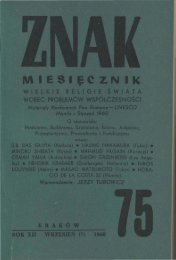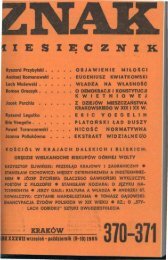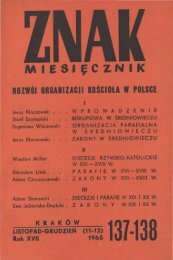Create successful ePaper yourself
Turn your PDF publications into a flip-book with our unique Google optimized e-Paper software.
ISUMMARY I<br />
In one of the previous issues (January <strong>1992</strong>) we followed up the paths of<br />
the heritage of Antiquity. This one in turn is devoted to the heritage of the<br />
Middle Ages. It begins with a conversation that Philippe Sainteny held with<br />
two notable historians who specialize in that epoch: Georges Duby and<br />
Bronislaw Geremek. Then Czeslaw Deptula recalls the vision of history and<br />
the Universe as it emerges out of the culture and popular beliefs prevalent in<br />
the Middle Ages. Stefan Wilkanowicz and Jerzy Kloczowski consider the<br />
inspirations as well as perils born of that epoch, especially as regards the<br />
state-Church relations. Jan Drabina's essay treats of the religious heritage of<br />
the Middle Ages and delineates the picture of the Chl'rch of that day. In the<br />
author's opinion, the Christianity of that period was subject to the adverse<br />
influences exerted by "the spirit of the time", which left little room for<br />
tolerance, but at the same time in this very epoch Christian spirituality<br />
flourished ever so splendidly. A text by Hilda Graef tells of one of its finest<br />
achievements, the work of Bernard of Clairvaux.<br />
Three articles that follow next depict the heritage of the Middle Ages'<br />
culture. Gerhart B. Ladner re-creates the image of man as it was rooted in<br />
the theology and the spiritual atmosphere of that epoch. Wojciech Ballis<br />
looks for the roots of one of "the cardinal sins" that are ailing modern<br />
culture, namely boredom, tracing them back to the Middle Ages; boredom<br />
used to be referred to as "acedia" by the sages of the soul. Zygmunt Kubiak<br />
in his turn reflects upon the affinit ies between Dante's Divine Comedy and<br />
ancient poetry. The whole group of texts focused around the heritage of the<br />
Middle Ages ends with Krzysztof Kowalski's sketch on Christopher Columbus<br />
seen as one who sought after a paradise on Earth.<br />
The second part of the issue centers around Jozef Czapski, an illustrious<br />
painter and writer. Krystyna Czerni writes about the connections between<br />
Czapski, who lived abroad, and post-war Polish art. Janusz Marciniak<br />
reveals Czapski's vision of art as a metaphysical necessity, while Tomasz<br />
Gryglewicz ponders the meaning of the term "cultured" as applied to<br />
Czapski's painting .<br />
. ' In the "Subjects and Reflection" section readers will find an essay by<br />
Andrzej C. Leszczynski on the need to work out a model of everyday culture<br />
in response to social ills, Jan A. Kloczowski considerations of the symbolic<br />
meaning of fire, and Michal Heller's remarks on the cosmological background<br />
of modern physics.<br />
The "Events-Books-People" section contains Stanislaw Primus' essay on<br />
Edward Hopper's painting, reviews of Louis Dupre's On the &sence of<br />
Religion (by Ireneusz Zieminski), Julian Stryjkowski's Survivor in the East (by<br />
Anna Nasilowska), and Battista Mondin's St. Thomas' Dictionary (by Janusz<br />
Krolikowski); finally, Zdzislaw Kijas OFM presents and comments on the<br />
attitude of Latin American bi shops towards the problem of inculturation of<br />
the Gospel.


